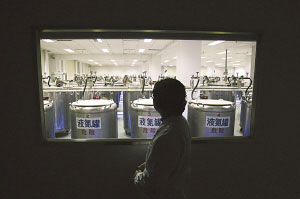
A worker views liquid nitrogen cans used to store cord blood in Beijing's cord blood bank on Tuesday, February 26, 2008. [Photo: The Beijing News]
Two human umbilical cord blood banks in the cities of Beijing and Tianjin have received the authorization from the Ministry of Health and opened to the public.
Cord blood bank is a very important storage to preserve baby's cord blood for potentially lifesaving uses.
Dozens of people came from Beijing and some other cities watched the whole process of taking cord blood outside a window, reported The Beijing News.
Fresh blood taken from a newborn's umbilical cord should pass a series of procedures, including sterilization, weighing, bacteria detecting, testing vitality of the stem cell, and then frozen by liquid nitrogen with a temperature of 196 degrees below zero.
According to a plan by the Ministry of Health, China will build 4 to 10 cord blood banks before 2010.
Six banks have been built in three municipalities of Beijing, Tianjin, Shanghai, and provinces of Guangdong, Sichuan and Shandong.
Beijing's cord blood bank, initiated in 1996, has the largest liquid nitrogen storage in China. More than 100 liquid nitrogen cans under electronic real-time monitors store 40,000 units of cord blood. One quarter of these units are donations.
CEO of Beijing's cord blood bank, Gao Feng told that this bank has provided 56 units of cord blood to 47 patients for non-kinship stem cells transplantations.
Statistics released by the Ministry of Health show that 25,000 units of cord blood have been donated to those banks.
The successful cases of stem cells transplantations relying on donated cord blood have reached 400.
Experts estimated that the storage of cord blood, exceeding 70,000 to 100,000 units, can fulfill the clinic demand of treatment for leukemia, metabolic disease and etc.
To achieve the goal mentioned above, Beijing's cord blood bank will introduce knowledge about the importance of cord blood banking to the public on some weekends.
(CRIENGLISH.com February 27, 2008)